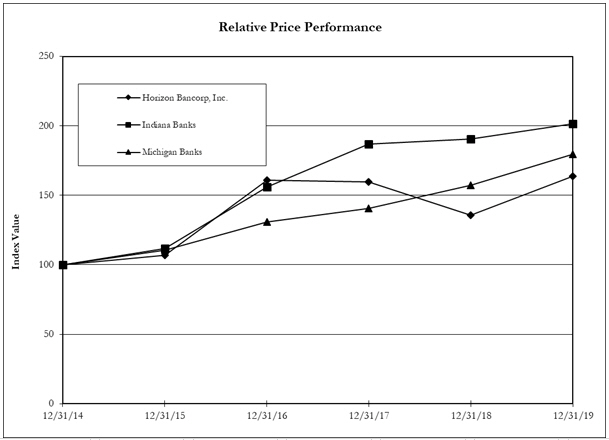Horizon Bancorp, Inc. and Subsidiaries
Management’s Discussion and Analysis of
Financial Condition and Results of Operations
(Table dollars in thousands except per share data)
Income tax expense totaled $13.3 million for the year ended December 31, 2019, an increase of $2.9 million when compared to the year ended December 31, 2018. The increase was primarily due to an increase in income before income tax expense of $16.3 million when comparing 2019 to the prior year.
Income tax expense totaled $10.4 million for the year ended December 31, 2018, a decrease of $4.4 million when compared to the year ended December 31, 2017. The decrease was primarily due to the impact of the new corporate tax rate established by the Tax Cuts and Jobs Act which was signed into law at the end of 2017 and the benefits from the exercising of stock options. In addition to a lower corporate tax rate being applied to 2018 income, a revaluation to Horizon’s net deferred tax asset of $2.4 million was recorded to income tax expense during the fourth quarter of 2017. Partially offsetting these decreases to income tax expense was an increase in income before income tax expense of $15.6 million when comparing 2018 to the prior year.
Expected Replacement of London Interbank Offered Rate
The ARRC continues its work to the goal of finding suitable replacements for LIBOR. It is expected that a transition away from the widespread use of LIBOR to alternative reference rates and other potential interest rate benchmark reforms will occur over the course of the next few years. Although the full impact of such reforms and actions, together with any transition away from LIBOR remains unclear, we are preparing to transition from the LIBOR to an alternative reference rate.
Our transition plan includes a number of key steps, including continued engagement with central bank and industry working groups and regulators, active client engagement, internal operational readiness, and risk management, among other things, to promote the transition to alternative reference rates. We are identifying
on-balance
sheet and
off-balance
sheet references to LIBOR, determining appropriate language to replace the LIBOR index language, and determining disclosures necessary for customers, with appropriate procedures and schedules to complete the LIBOR transition.
There remain, however, a number of unknown factors regarding the transition from LIBOR or interest rate benchmark reforms that could impact our business, including, for example, the pace of the transition to replacement or reformed rates, the specific terms and parameters for and market acceptance of the alternative reference rates, prices of and the liquidity of trading markets for products based on the alternative reference rates, and our ability to transition to and develop appropriate systems and analytics for one or more alternative reference rates. For a further discussion of the various risks we face in connection with the expected replacement of LIBOR and reform of interest rate benchmarks on our operations, see “Risk Factors – Risks Related to Our Business.”
Use of
Non-GAAP
Financial Measures
Certain information set forth in this report on Form
10-K
refers to financial measures determined by methods other than in accordance with GAAP. Specifically, we have included
non-GAAP
financial measures relating to net income, diluted earnings per share, net interest margin, total loans and loan growth, the allowance for loan and lease losses, tangible stockholders’ equity, tangible book value per share and the return on average assets and average common equity. In each case, we have identified special circumstances that we consider to be
non-recurring
and have excluded them, in order to show the impact of such matters as acquisition-related purchase accounting adjustments, prepayment penalties on borrowings and the Tax Cuts and Jobs Act, among other matters we have identified in our reconciliations. Horizon believes these
non-GAAP
financial measures are helpful to investors and provide a greater understanding of our business without giving effect to the purchase accounting impacts and
one-time
costs of acquisitions and
non-core
items. These measures are not necessarily comparable to similar measures that may be presented by other companies and should not be considered in isolation or as a substitute for the related GAAP measure. See the following tables for reconciliations of the
non-GAAP
measures identified in this Form
10-K
to their most comparable GAAP measures.



